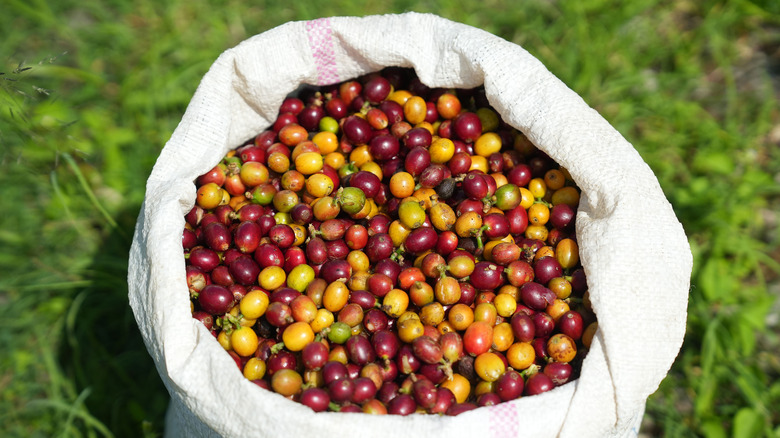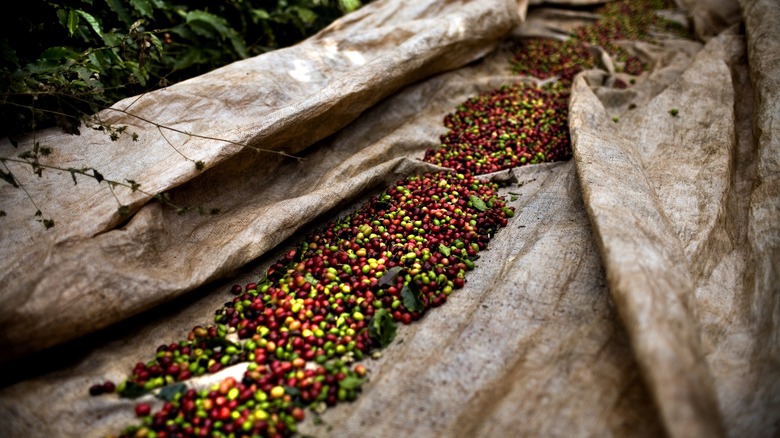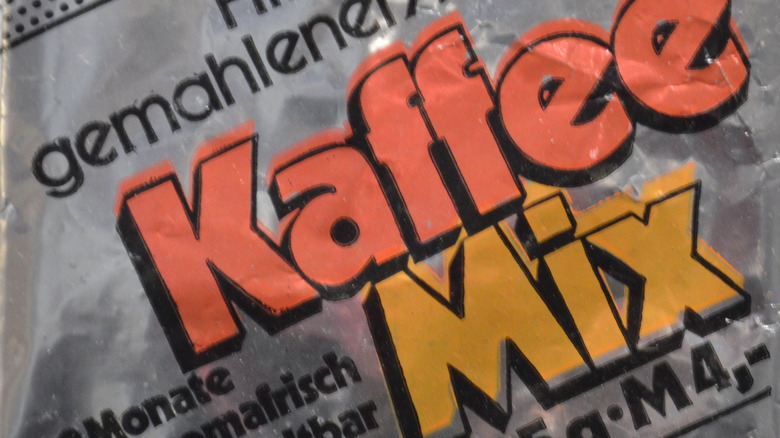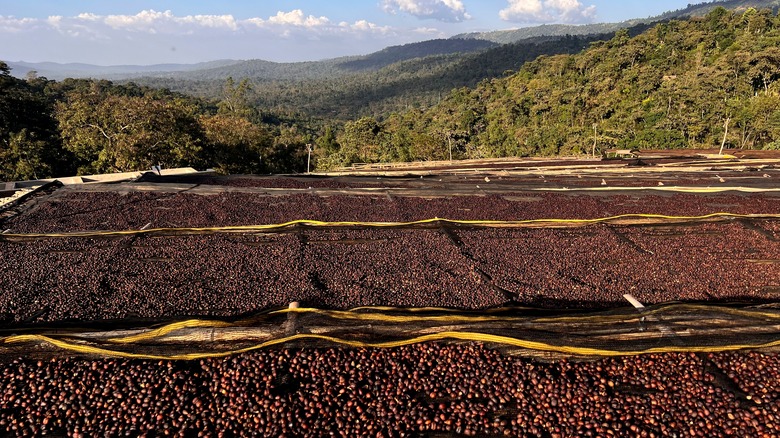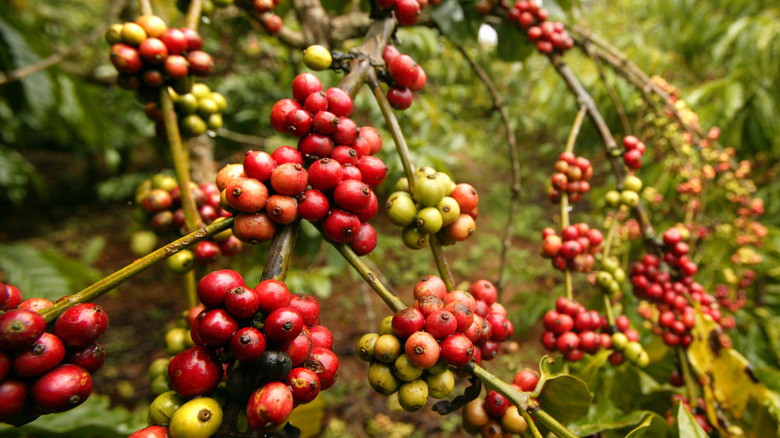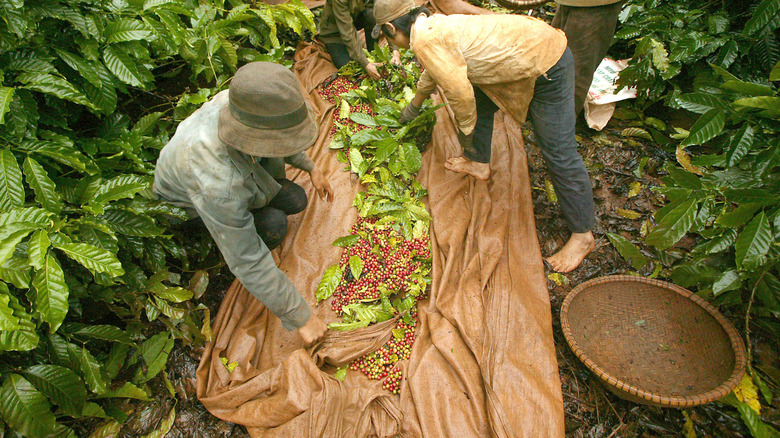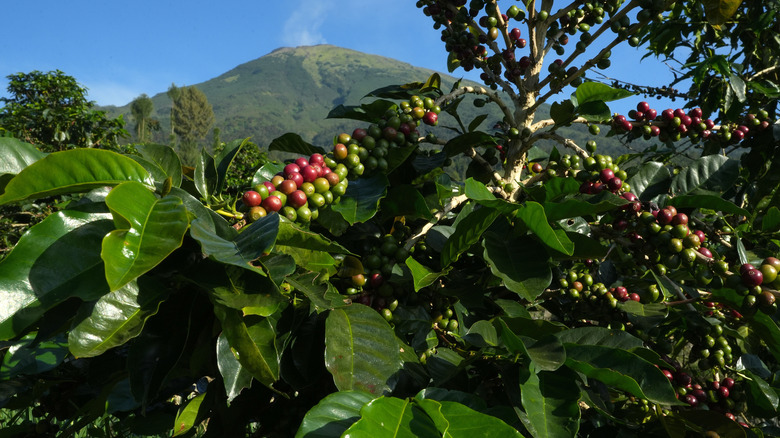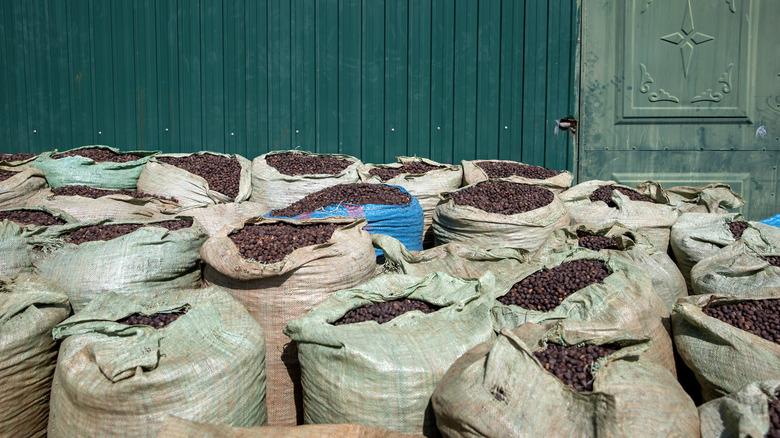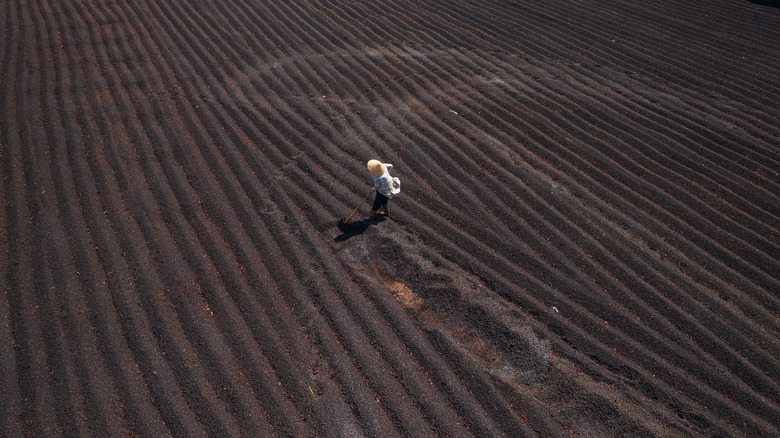The East German Coffee Crisis Of The 1970s Explained
One might not initially consider the Vietnamese coffee industry as having anything to do with Germany, but roughly 50 years ago, East Germany quite literally planted the seed of the Vietnamese coffee industry. By the time that seed had grown to harvest, East Germany didn't exist anymore, but the coffee exports out of Vietnam now rival that of Brazil, the largest coffee producer in the world.
At the time, East Germany boasted of the project as an achievement of socialist cooperation. And even today, Vietnam's economic vitality when it comes to coffee production is hailed as a success. But what did creating all this coffee really entail?
The economic effects of the coffee plantations aren't the only ones that continue to be felt. Deforestation and pollution are also seen as long-term effects of the coffee production industry that cast a shadow on the economic successes of the Vietnamese coffee industry. This is the East German coffee crisis of the 1970s explained.
Coffee in East Germany
After the Second World War, East Germany, also known as the German Democratic Republic, was receiving most of its coffee imports from the Soviet Union. But even despite the imports, there were still coffee shortages in East Germany. Some East Germans received coffee in care packages from their families in the West, but Andrew Kloiber writes in "Brewing Socialism" that the amount was limited to 250 grams in 1954.
According to "Communism Unwrapped," edited by Paulina Bren and Mary Neuburger, by the 1960s, East Germany was importing coffee from several countries worldwide at a cost of 300 million dollars per year. The East German government represented the coffee imports to socialism and worker achievements, due to the fact that domestic production was necessary in order to import goods. "Coffee was not a given, but it was a product to which the regime committed resources, tying its political legitimacy to fulfilling its promise to improve living standards," according to "Food, Culture and Identity in Germany's Century of War," edited by Heather Merle Benbow and Heather R. Perry.
However, from 1955 to 1970, West Germany actively obstructed East Germany's trade relations with the Hallstein Doctrine, which maintained that countries that recognized East Germany would not be allowed to trade with West Germany.
Brazil black frost of 1975
From July 17 to 20, 1975, Brazil was hit by a severe cold front that decimated the coffee trees. In the regions of Paraná, São Paulo, and Minas Gerais, between one-third to half of all coffee trees were killed, totaling around 1.5 billion coffee trees. It was so cold that snow fell in Paraná for the first time in record history, and as a result of the severe frost, 600,000 people lost their jobs.
In what became known as the "Black Frost," the coffee trees died after being completely frozen inside and out and turning black. The name came from a comparison with cold snaps known as white frosts, which only kill the leaves and flowers.
Because most of the coffee beans had recently been harvested, the effect of the dead coffee trees wouldn't be felt until the following year. But what followed was effectively a global coffee shortage through the late 1970s, since Brazil supplied up to one-third of the global coffee supply. During this time, other prominent exporting countries in the world coffee market, like Ethiopia and Angola, were in the midst of civil wars. Even before there was an actual shortage of coffee beans, the price of coffee quadrupled soon after the black frost quadrupled due to panic purchasing. By 1977, the price of coffee set by the International Coffee Organization had more than tripled to $2.29 per pound. The price wouldn't fall until 1980.
A Kaffee-mix
With the rising prices of coffee beans, East Germany was struck by a coffee shortage. Unable to purchase things on the global market with East German currency, a coffee mixture was created as a coffee substitute. Known as Mischkaffee or Kaffee-mix, the coffee substitute included some real coffee mixed with things like pea flour, rye, or sugar beets.
East Germans were not fans of the drink, and not only due to its taste: When used in a coffee machine, the mixture would clog up the filters and break the machine. By the end of 1977, the government had received up to 14,000 petitions complaining about the Kaffee-Mix. The mix was also called disparagingly called Erichs Krönung, a play on the Chairman of the Council of State Erich Honecker's name and a West German coffee brand known as Jacob's Krönung. This was a problem for a government that'd planned for the Kaffee-Mix to take up 80% of the total coffee supply.
This wasn't the first time that Germany was forced to create a coffee substitute. During World War I, rationing and shortages of coffee led to the creation of a similar coffee substitute, called ersatz coffee.
Coffee for Stollen
Another coffee option for East Germans was trading coffee for Dresdener Stollen, a cake made with fruits and nuts that is typically eaten around Christmas or Easter. Families in West Germany often requested a Stollen in exchange for sending coffee in a care package, but as Christoph Wener writes in "Lifting the Iron Curtain," some of the ingredients used in a stollen, like almonds, also needed to be bought from abroad, or with non-East German currency.
Sending coffee from the West to the East was also seen as a way of actualizing the communal ties that were otherwise physically apart. In a letter accompanying a care package to the East, Erika Schneider wrote: "I always say, since we cannot drink the coffee at the same table, let us at least drink the same brand," per "Biographies and the Division of Europe," by Roswitha Breckner. Ultimately, up to 25% of the coffee in East Germany ended up coming from friends and family in the West.
Bartering with African countries
With the almost universal hatred of the Kaffee-Mix, the East German government realized that they had to find some way to get actual coffee into the country. But coffee needed to be purchased with foreign money, and it had been hard enough for East Germany to purchase coffee on the world market even before the costs skyrocketed. It was projected that if East Germany actually purchased coffee for a few years, the whole country would go bankrupt.
Instead, East Germany decided to make barter exchanges with African countries with socialist leanings like Angola, Ethiopia, Mozambique, São Tomé, and Príncipe. According to "The Socialist Good Life," edited by Cristofer Scarboro, Diana Mincyte, and Zsuzsu Gille, in the case of Ethiopia, East Germany received raw coffee in exchange for weapons and military equipment, effectively assisting Mengistu Haile Mariam's dictatorial regime against a civil war. Meanwhile, in Angola, coffee was exchanged for the East German W50 truck. According to "Transregional Connections in the History of East-Central Europe," edited by Katja Castryck-Naumann," this led to Angola becoming the largest export market for W50 trucks in Africa by 1987.
Up through 1978, coffee imports from Ethiopia and Angola accounted for 40% of East Germany's coffee imports and were used to create the East German coffee brand known as Rondo. But by 1979, their contracts with East Germany had expired, which meant that East Germany had to come up with another, ideally long-term, solution to their coffee crisis.
Growing coffee in Vietnam
By the end of 1977, the East German government had already set its sights on Vietnam as an answer to its coffee crisis. Because neither Germany nor Vietnam were part of the International Coffee Organization, they didn't have to abide by the ICO's set import and export quotas. And although negotiations took a few years, by the time East Germany's barter agreements with African countries were coming to an end, Vietnam agreed to the creation of a coffee plantation in Dak Lak in August 1980.
The agreement entailed for Vietnam to export half of its entire coffee production to East Germany, starting in the late 1980s, when the coffee was ready for harvesting. In exchange, East Germany would send equipment and materials for coffee production, as well as specialists to train the Vietnamese workers. All-in-all, East Germany ended up investing roughly $20 million into coffee production in Vietnam. According to "Comrades of Color," edited by Quinn Slobodian, most of this money went into building a water power plant.
The agreement allowed for over 10,000 hectares of coffee trees to be planted and maintained, known as the Kombinat Viet-Duc. And within just a few decades, coffee production in Vietnam would explode from 6,000 hectares of coffee fields in 1975 to 130,000 hectares in 1997.
Resettling people
As part of the coffee production plan, thousands of people needed to be brought in to work the coffee fields. After Vietnam had started producing coffee in 1975, some people had migrated to Dak Lak to work in the coffee fields. But by 1977, up to 75,000 people had been forcibly resettled in Dak Lak to work the coffee fields. The coffee plantations were considered part of Vietnam's New Economic Zones program.
Between 1976 and 1996, over 300,000 people were resettled in Dak Lak. This resettlement program drastically changed the demographics of the Central Highlands, where the coffee production was taking place. According to "The Indigenous World 2005," edited by Diana Vinding, so many Kinh people were resettled in Dak Lak that by 1989, Kinh people made up 70% of the population. Another 350,000 people also migrated to Dak Lak in search of economic opportunities, so that the other indigenous ethnic groups of the region, known as người Thượng, or highlanders, that once made up 95% of the population were reduced to a minority. Many people were brought in especially because local indigenous people were against the coffee plantations and refused to participate.
According to "Telecoupling," edited by Cecilie Friis and Jonas Ø. Nielsen, many Kinh people chose to migrate to work on the coffee plantations due to agricultural expansion subsidies offered by the government.
Providing machinery to Vietnam
In exchange for all the coffee that East Germany would get from Vietnam once the coffee harvests would be ready in the late 1980s, East Germany also sent machinery to be used in cultivation, fertilizers, and pesticides. East German workers also traveled to Vietnam, living in former French plantation homes while they assisted the Vietnamese people with coffee cultivation.
Much of the infrastructure, like hospitals, schools, and housing, that the new migrants and settlers used were also built by East German workers. And the physical infrastructure wasn't all that the East Germans helped the Vietnamese build. According to The Vietnamese, In addition to the agreement regarding coffee plantations, Vietnam and East Germany signed an agreement in October 1980 that involved the exchange of information and counter intelligence. This meant that the Stasi became quite involved in helping construct Vietnam's public security forces.
In addition to sending East Germans to Vietnam to build and train people in coffee production, specialists from Vietnam also traveled to East German for training. However, these exchanges and East German investments into Vietnam were often exaggerated within East Germany, such as The Berliner Zeitung's reporting that over 70,000 hectares of coffee fields were planned in Vietnam.
Unable to reap what was sown
The coffee plantations started yielding coffee fruits in 1986, of which East Germany imported roughly 5,000 tons of coffee beans. But unfortunately, East Germany would never really have a chance to reap what they had pushed Vietnam to sow. There were only about three years of coffee harvests before East Germany dissolved and was reunited with West Germany.
By 1989, the Kombinat Viet-Duc coffee fields were the largest coffee plantation in the country. But East Germany would be dissolved within a year, on October 3, 1990. And this effectively rendered any coffee agreements with Vietnam null and void, since the country of East Germany that had made the agreements no longer existed.
Despite the fact that East Germany was unable to reap the benefits of their coffee investment, Vietnam utilized the blossoming coffee fields to become the second largest coffee producer in the world, following Brazil. And even though the coffee agreement between Vietnam and East Germany dissolved along with the DDR, the coffee ties between Vietnam and Germany persist into the present day. As of 2022, Germany continues to source much of its coffee from Vietnam, with Brazil, Vietnam, and Honduras being the top coffee importers to Germany. And Germany imports roughly 13% of Vietnam's coffee harvest, making it the top consumer of Vietnamese coffee in the world.
Effects of the coffee industry
The appropriation of land for the purpose of coffee cultivation has led to several long-term detrimental effects. Not only have indigenous groups in Vietnam like the K'ho people lost access to their lands, but the coffee plantations have caused soil erosion and water pollution.
Since the 10,000 hectares of coffee fields were created in league with East Germany, the coffee plantations in Vietnam have grown to over 200,000 hectares. And all these coffee plantations need a great deal of water to support their growth. According to "Environmental Sustainability and Climate Change Adaptation Strategies," the need for water led to the creation of many small reservoirs for coffee irrigation, which ended up using all of the ground and surface water. And this not only affects Vietnam, but downstream Cambodia as well.
The use of fertilizers and pesticides during coffee production has also contributed to the pollution of the water. But because the Vietnamese government started subsidizing chemical fertilizers in the 1990s, many farmers will use them despite their many negative long-term effects, like making the soil infertile, according to Sustainability.
